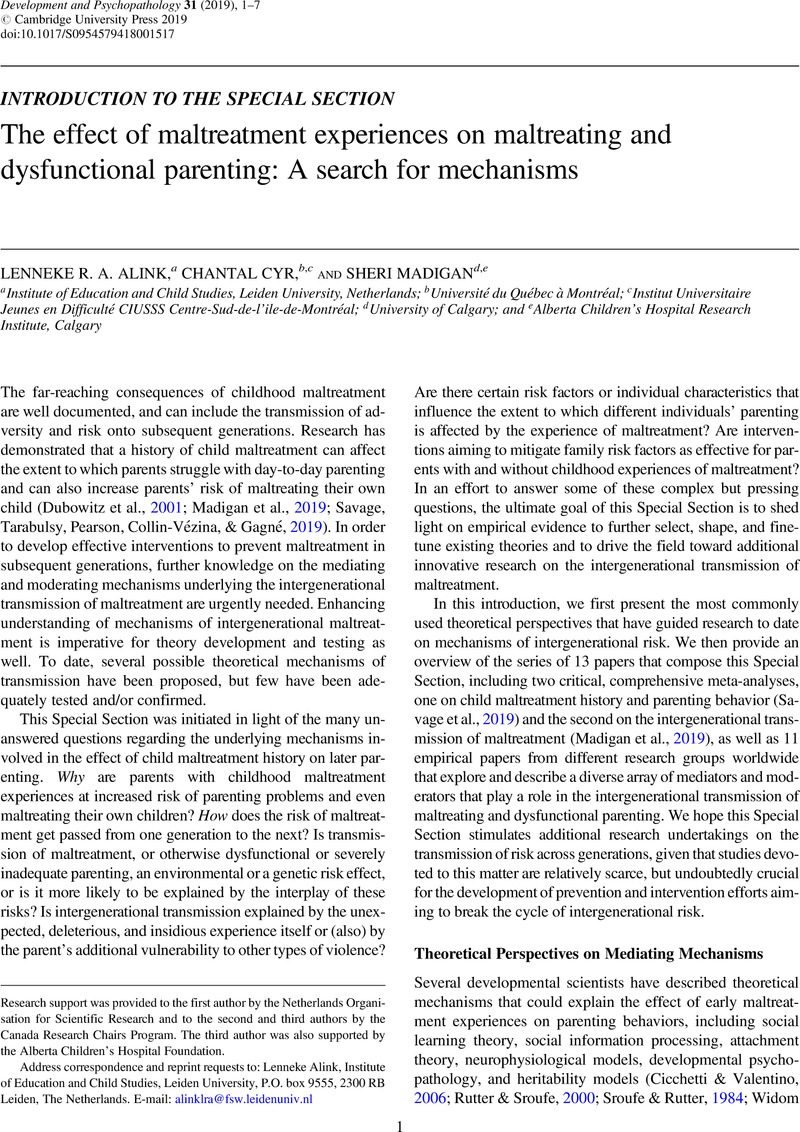Crossref Citations
This article has been cited by the following publications. This list is generated based on data provided by Crossref.
Madigan, Sheri
Cyr, Chantal
Eirich, Rachel
Fearon, R. M. Pasco
Ly, Anh
Rash, Christina
Poole, Julia C.
and
Alink, Lenneke R. A.
2019.
Testing the cycle of maltreatment hypothesis: Meta-analytic evidence of the intergenerational transmission of child maltreatment.
Development and Psychopathology,
Vol. 31,
Issue. 1,
p.
23.
Cooke, Jessica E.
Racine, Nicole
Plamondon, Andre
Tough, Suzanne
and
Madigan, Sheri
2019.
Maternal adverse childhood experiences, attachment style, and mental health: Pathways of transmission to child behavior problems.
Child Abuse & Neglect,
Vol. 93,
Issue. ,
p.
27.
Berthelot, Nicolas
Lemieux, Roxanne
and
Maziade, Michel
2019.
Shortfall of Intervention Research Over Correlational Research in Childhood Maltreatment.
JAMA Pediatrics,
Vol. 173,
Issue. 11,
p.
1009.
Frieze, Irene Hanson
Newhill, Christina E.
and
Fusco, Rachel
2020.
Dynamics of Family and Intimate Partner Violence.
p.
179.
Frieze, Irene Hanson
Newhill, Christina E.
and
Fusco, Rachel
2020.
Dynamics of Family and Intimate Partner Violence.
p.
17.
Warmingham, Jennifer M.
Rogosch, Fred A.
and
Cicchetti, Dante
2020.
Intergenerational maltreatment and child emotion dysregulation.
Child Abuse & Neglect,
Vol. 102,
Issue. ,
p.
104377.
Hubel, G.S.
Davies, F.
Goodrum, N.M.
Schmarder, K.M.
Schnake, K.
and
Moreland, A.D.
2020.
Adverse childhood experiences among early care and education teachers: Prevalence and associations with observed quality of classroom social and emotional climate.
Children and Youth Services Review,
Vol. 111,
Issue. ,
p.
104877.
Browne, Dillon T.
May, Shealyn
and
Lieberman, Alicia
2020.
Traumatic Events and Associated Symptoms amongst Caregiver-Child Dyads: Exploring Caregiver Sex Differences.
Journal of Child and Family Studies,
Vol. 29,
Issue. 8,
p.
2155.
Khoury, Jennifer E.
Beeney, Joseph
Shiff, Ilana
Bosquet Enlow, Michelle
and
Lyons‐Ruth, Karlen
2021.
Maternal experiences of childhood maltreatment moderate patterns of mother–infant cortisol regulation under stress.
Developmental Psychobiology,
Vol. 63,
Issue. 5,
p.
1309.
Liu, Siman
Dong, Shuyang
and
Wang, Zhengyan
2021.
Maternal History of Childhood Maltreatment and Control Strategies: A Search for Mechanisms.
Journal of Marriage and Family,
Vol. 83,
Issue. 4,
p.
1099.
Fuchs, Anna
Lunkenheimer, Erika
and
Brown, Kayla
2021.
Parental history of childhood maltreatment and child average RSA shape parent–child RSA synchrony.
Developmental Psychobiology,
Vol. 63,
Issue. 6,
Browne, Dillon Thomas
Smith, Jackson Andrew
and
Basabose, Jean de Dieu
2021.
Refugee Children and Families During the COVID-19 Crisis: A Resilience Framework for Mental Health.
Journal of Refugee Studies,
Vol. 34,
Issue. 1,
p.
1138.
Reid, Carol
McKenzie, Joanne E
Brennan, Sue E
Bennetts, Shannon K
Clark, Yvonne
Mensah, Fiona
Hokke, Stacey
Ralph, Naomi
Brown, Stephanie J
Gee, Graham
Nicholson, Jan M
and
Chamberlain, Catherine
2021.
Interventions during pregnancy or up to two years after birth for parents who are experiencing complex trauma or have experienced maltreatment in their childhood (or both) to improve parenting capacity or socio-emotional well-being.
Cochrane Database of Systematic Reviews,
Vol. 2021,
Issue. 7,
Cao, Ruixin
Li, Hechun
and
Zhang, Huiping
2022.
Intergenerational Transmission of Violence Among Substance-Abusing Chinese Parents: Roles of Detachment and Social Support.
Journal of Interpersonal Violence,
Vol. 37,
Issue. 19-20,
p.
NP18713.
Khoury, Jennifer E.
Ahtam, Banu
Sisitsky, Michaela
Ou, Yangming
Gagoski, Borjan
Enlow, Michelle Bosquet
Teicher, Martin H.
Grant, P. Ellen
and
Lyons-Ruth, Karlen
2022.
Maternal Childhood Maltreatment Is Associated With Lower Infant Gray Matter Volume and Amygdala Volume During the First Two Years of Life.
Biological Psychiatry Global Open Science,
Vol. 2,
Issue. 4,
p.
440.
Martoccio, Tiffany L.
Berlin, Lisa J.
Aparicio, Elizabeth M.
Appleyard Carmody, Karen
and
Dodge, Kenneth A.
2022.
Intergenerational Continuity in Child Maltreatment: Explicating Underlying Mechanisms.
Journal of Interpersonal Violence,
Vol. 37,
Issue. 1-2,
p.
973.
Berzenski, Sara R.
and
Yates, Tuppett M.
2022.
Handbook of Child Maltreatment.
Vol. 14,
Issue. ,
p.
351.
Landry, Jyllenna
Asokumar, Ajani
Crump, Carly
Anisman, Hymie
and
Matheson, Kimberly
2022.
Early life adverse experiences and loneliness among young adults: The mediating role of social processes.
Frontiers in Psychology,
Vol. 13,
Issue. ,
Milner, Joel S.
Crouch, Julie L.
McCarthy, Randy J.
Ammar, Joe
Dominguez-Martinez, Rodrigo
Thomas, Courtney L.
and
Jensen, Audra P.
2022.
Child physical abuse risk factors: A systematic review and a meta-analysis.
Aggression and Violent Behavior,
Vol. 66,
Issue. ,
p.
101778.
Milan, Stephanie
Carlone, Christina
Printz, Destiny
and
Perez, Sophia Dominguez
2022.
Understanding Children’s Emotions: Differences in Mothers With a History of Childhood Maltreatment.
Child Maltreatment,
Vol. 27,
Issue. 1,
p.
33.





